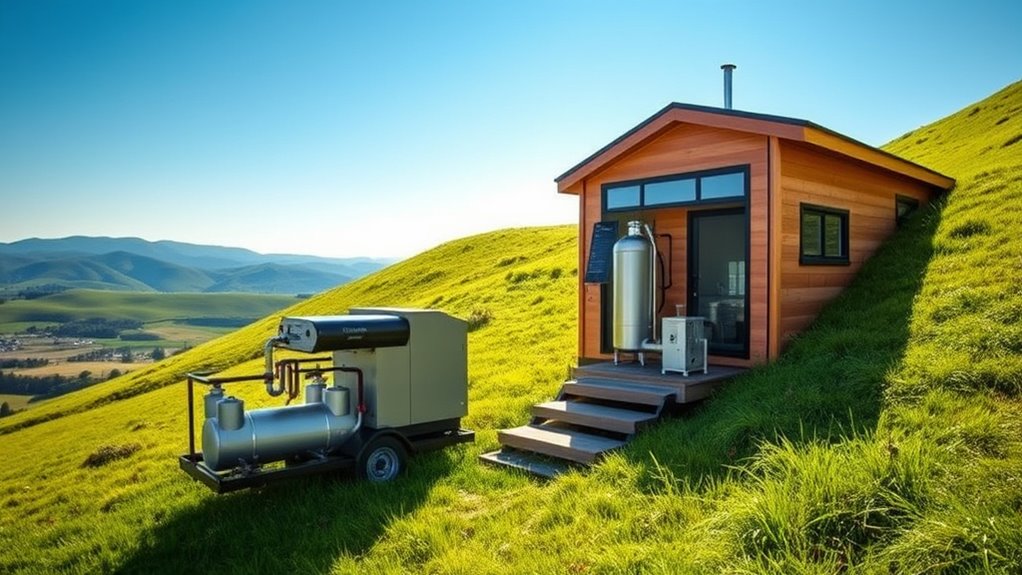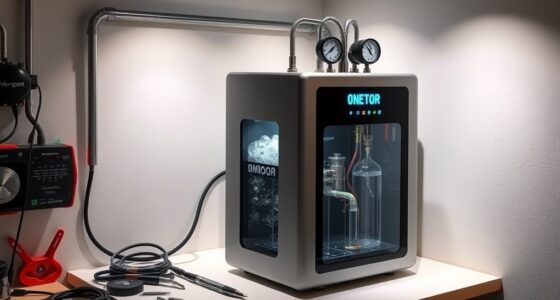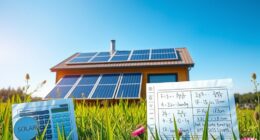Hydrogen energy systems for tiny houses provide a clean, efficient way to generate power using fuel cell technology, which converts hydrogen into electricity with over 60% efficiency. Storage safety is vital, so systems include reinforced tanks and leak detection features. These systems are compact, quiet, and ideal for off-grid living, offering long-term savings and sustainability. If you keep exploring, you’ll discover how ongoing advancements are making hydrogen systems safer, more affordable, and easier to maintain.
Key Takeaways
- Hydrogen fuel cells convert hydrogen into electricity with over 60% efficiency, ideal for sustainable tiny house energy needs.
- Safe hydrogen storage involves reinforced tanks, leak detection, and pressure relief features to prevent accidents.
- Regular maintenance of fuel cells and inspection of storage tanks ensure system longevity and optimal performance.
- Compact hydrogen systems provide clean, quiet power suitable for small spaces and off-grid tiny house living.
- Ongoing technological advances improve efficiency, safety features, and affordability, supporting eco-friendly tiny house energy independence.

Hydrogen energy systems are rapidly transforming the way we think about clean power. For tiny houses, this innovation offers a promising way to generate electricity sustainably while maintaining independence from traditional grid connections. At the heart of this system are fuel cells, which convert hydrogen directly into electricity through electrochemical reactions. The efficiency of these fuel cells plays a pivotal role in determining how well your tiny home can harness this energy. Modern fuel cells are designed to maximize efficiency, often reaching over 60%, meaning you get more power from less hydrogen. This improved efficiency translates into longer-lasting energy supplies and lower operational costs, making hydrogen a practical choice for eco-conscious homeowners. However, efficiency isn’t just about performance; safety is equally essential. Storage safety becomes a key concern when dealing with hydrogen, a highly flammable gas. You need to guarantee that your storage tanks are built with rigorous safety standards, incorporating features like reinforced materials, pressure relief valves, and secure venting systems. Proper storage safety minimizes risks of leaks or accidents, giving you peace of mind as you rely on hydrogen for your energy needs. Many systems now feature integrated safety mechanisms that automatically detect leaks and shut off supplies, further enhancing security. When considering hydrogen for your tiny house, you’ll also want to evaluate how easily the system can be maintained. Fuel cells require regular checks to ensure maximum efficiency, and storage tanks must be inspected periodically for integrity. Fortunately, advancements in hydrogen storage technology have made it safer and more straightforward to handle, with innovations like composite tanks that are lightweight yet robust. Additionally, the infrastructure for refueling or recharging hydrogen systems is improving, making it easier for you to keep your tiny house powered without extensive hassle. As you explore these systems, you’ll notice that their compact design fits perfectly into small spaces, offering a clean, quiet, and efficient energy source. While initial setup might involve some investment, the long-term savings on energy costs and the environmental benefits make hydrogen energy systems a compelling choice. Plus, with ongoing technological advancements, fuel cell efficiency continues to improve, and storage safety features become more sophisticated and user-friendly. This means you’ll benefit from safer, more reliable energy solutions that support your sustainable living goals. Moreover, some systems incorporate Honda Tuning-inspired performance enhancements to optimize energy output and system responsiveness. Ultimately, integrating hydrogen energy into your tiny house can give you the freedom to live off-grid, reduce your carbon footprint, and enjoy the benefits of cutting-edge clean energy technology. As you consider this option, remember that safety, efficiency, and ease of maintenance are the pillars for a successful and sustainable hydrogen-powered tiny home.
Frequently Asked Questions
How Long Can a Tiny House Run on a Hydrogen Energy System?
You can run a tiny house on a hydrogen energy system for several days to weeks, depending on your hydrogen storage capacity and energy efficiency. Larger storage tanks allow longer operation, while efficient fuel cells maximize usage. To extend run time, guarantee your system minimizes energy waste and uses high-quality components. With proper management, hydrogen fuel can power your tiny house reliably, offering sustainable energy for an extended period.
What Are the Safety Measures for Hydrogen Storage in Tiny Houses?
Did you know that hydrogen gas is flammable over a wide range of concentrations? To guarantee storage safety in your tiny house, you should use leak prevention measures like high-quality seals and sensors. Regularly check storage containers for corrosion or damage, and install proper ventilation systems to prevent gas buildup. These precautions help minimize risks, keeping you safe while harnessing hydrogen energy efficiently.
Is Hydrogen Energy Cost-Effective Compared to Solar or Wind?
Hydrogen energy can be cost-effective compared to solar or wind when you consider long-term benefits, but the cost comparison depends on installation, storage, and maintenance. Currently, solar and wind are often more economically viable due to lower setup costs, but hydrogen offers advantages in energy storage and flexibility. You should evaluate the economic viability based on your energy needs, local resources, and potential subsidies to determine which system suits you best.
Can Existing Tiny Houses Be Retrofitted With Hydrogen Systems Easily?
Did you know that retrofitting tiny houses with hydrogen systems can take anywhere from a few days to several weeks? You might face some challenges, like limited space and compatibility issues, but hydrogen integration is feasible with careful planning. The key retrofitting challenges include ensuring safety and proper storage. With expert help, you can smoothly upgrade your tiny house to harness hydrogen energy, making it more sustainable and energy-efficient.
What Is the Environmental Impact of Producing Hydrogen for Tiny Houses?
Producing hydrogen for tiny houses can considerably impact your environment, especially if generated from fossil fuels, increasing your carbon footprint. However, using renewable energy sources like solar or wind for electrolysis promotes resource sustainability and reduces emissions. By choosing green hydrogen, you help minimize environmental harm, support cleaner energy, and guarantee your tiny house’s energy system remains eco-friendly and sustainable over time.
Conclusion
Think of hydrogen energy systems as the gentle river that powers your tiny house, quietly flowing to keep everything running smoothly. Just like a river nourishes the land, hydrogen fuels your home sustainably, blending innovation with simplicity. Embracing this technology is like planting a seed that grows into a self-sufficient, eco-friendly oasis. With hydrogen, your tiny home becomes a shining beacon of progress, proving that small spaces can make a big, positive impact on our planet’s future.









